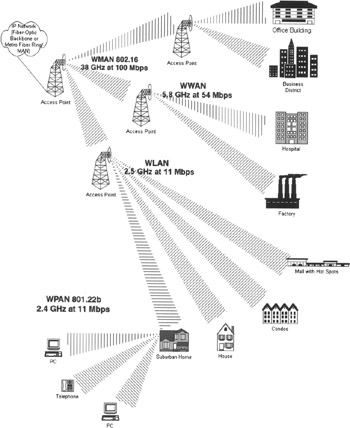Architecture: The Large Network Solution
|
|
Although a point-to-point 802.11b connection may have a range of 20 miles and a point-to-multipoint connection may have somewhat less range, building a wireless network to compete with the PSTN is considerably more complicated. Issues revolving around bandwidth sharing and frequency contention require a multitiered strategy for building a WMAN to replace the PSTN in a given municipality.
Overcoming limitations of range can be achieved through properly planning the architecture of a wireless network. Four elements of network architecture can be employed to extend the maximum range of 802.11b and its associated wireless protocols to cover an entire metropolitan area. First, a WMAN is fed from an Internet Protocol (IP) backbone at a high bandwidth—say, 100 Mbps. This WMAN would operate at a licensed frequency to ensure a high quality of transmission devoid of interference. The chief subscribers of the WMAN would be wireless Internet service providers (WISPs). The WMAN would then feed lesser networks, such as wireless wide area networks (WWANs). The WWANs could operate at 802.11a bandwidth (54 Mbps) at a frequency in the 5.8 GHz range. Subscribers of the WWAN would include large enterprises and smaller WISPs. The WWAN would, in turn, feed wireless local area networks (WLANs). WLANs would feed residences and small businesses. Wireless personal area networks (WPANs) would feed off WLANs to serve components within a given residence. Finally, an ad hoc peer-to-peer network, consisting of subscriber devices, intelligent APs, and wireless routers, could extend the network even further with little infrastructure cost. Figure 3-3 illustrates this process.

Figure 3-3: Covering a metro area with WMANs, WWANs, WLANs, and WPANs
|
|
EAN: 2147483647
Pages: 96